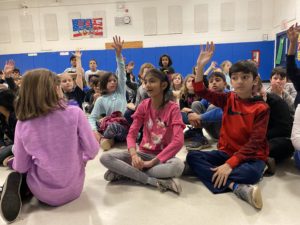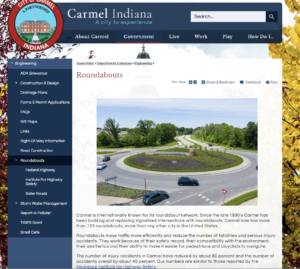Questions Kids Ask: Do You Ever Go Anywhere by Yourself?
April 1, 2021 • 16 Comments • Posted in blindness, Braille, parenting a child with special needs, questions kids ask, Seeing Eye dogs, technology for people who are blind, visiting schools The photo above on the right is one of then-new Seeing Eye dog Luna’s first and last in-person school visits in early March, 2020–before you-know-what happened. And now…we’re back!
The photo above on the right is one of then-new Seeing Eye dog Luna’s first and last in-person school visits in early March, 2020–before you-know-what happened. And now…we’re back!
Well, sort of.
Black Lab Luna and I made four school visits this past month and will be doing more in April — all of them via Zoom. So now, rather than getting dressed up and packing a backpack with dog bowl, Braille book, white cane, talking clocks and other cool blind stuff and then heading outside where my fabulous friend Jamie Ceaser picks me up at the break of dawn to drive me an hour to the suburban schools we visit, I just brush my teeth and hair, put a nice sweater on, sit on the floor in my office, call Luna to sit at my side, have Mike arrange my laptop on a footstool to aim it so the kids see both Luna and me in our little Zoom square, and… abracadabra! We are live on screen in the bedrooms of third-graders learning from home during COVID.
These Zoom classes exist thanks to Patty O’Machel. A special needs advocate and the mother of a teenager who has cerebral palsy, Patty launched her business Educating Outside the Lines in 2018 to encourage other schools to use the disability awareness curriculum she developed years ago for her daughter’s elementary school.
Many Chicago suburban school districts added the program to their curriculum, and for a few years now I’ve participated in person as one of the people children meet who use “helping tools” to get things done. During disability week, children at participating schools get to experience prosthetic legs, wheelchairs, sign language, Braille, talking iPhones, Seeing Eye dogs and white canes hands-on.
But there’s the rub: after March of last year, “hands-on” was no longer allowed.
So Patty went to work, developed an online alternative, met with the schools to talk about how online visits could work, and we’re giving it a go. Our visits are only 30 minutes long, Patty introduces Luna and me to the kids, the teacher askes them to “mute themselves” while I give a short talk, then the kids either use chat to send their questions to Patty to read out loud, or they “unmute themselves” when they’re called on.
I far prefer them unmuting themselves to ask. Without being able to see their tiny faces on screen, I rely on the enthusiasm in their voices to assure me my words are connecting with these very bright eight- and nine-year-olds.
So many of you Safe & Sound blog readers have told me you’re sorry all my school visits were cancelled this past year, how much you’ve missed hearing questions kids ask. So here we go with a sampling from the Braeside Elementary third-graders Luna and I met virtually this past Monday morning:
- How do you get into a car?
- Do you remember what things looked like when you were a little kid and could still see?
- So after you get in the car, how do you drive, I mean, like, there are all those buttons so how can you tell those buttons and how can you know which one to push?
- So if a friend comes to pick you up, how do you know if they’re there and it’s the right car?
- Before COVID, did you feel people’s faces to see what they looked like?
- Did you have to learn a lot of new things after you were blind?
- I hope you don’t mind me asking, but how old were you went you got blind?
- How does your dog know what your destination is? (And yes, the kid really did use the word “destination.”)
- How long did it take you to learn Braille?
- Do you ever go anywhere by yourself, or is your dog always with you?
- When you used to use a white cane, did you prefer using one with a ball at the end of it? (And yes, the kid really did use the word “prefer.”)
- I know what you mean about that Braille thing, I read a book about Helen Keller and it had a chart of all the Braille letters and it looked like it would be very difficult (okay, not a question, but I appreciated his empathy and his use of the word “difficult” there).
- Do you ever make mistakes? Like, you said you have Milk in a carton in your refrigerator but you have juice in cans, Did you ever pour a glass of juice and it ended up being milk instead?
- How many years have you been blind?
- What if you use your phone to call someone and you don’t have the number right?
- How do you know the clothes you’re wearing?
- How does it make you feel when you make a mistake?
Make no mistake here: I was wrong to doubt whether Zoom could work for these school visits. Zoom is not the same as a real visit (the kids can’t line up after I take Luna’s harness off at the end to pet her) but I feel like the kids and I do connect in some ways. At the very least it gives those hard-working teachers doing this all from home a well- deserved 30-minute break!


